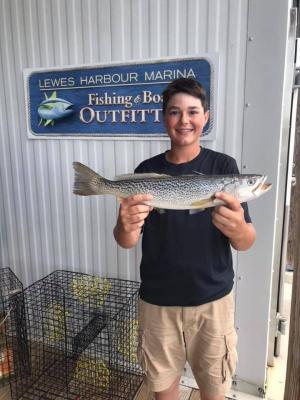Flounder fishing has been much better this year than I expected. The overall population has been down due to poor reproduction, but I guess no one told the flounder. As has been the case for several years, the count of sub-legal fish far outnumbers legal ones, but the better anglers still come back with their four-fish limit.
During the 1960s, ’70s and ’80s, I fished primarily in Indian River Bay and the nearshore ocean. We had a camper at Bayshore Campground in Ocean View from 1973-89, and I would get up before dawn, go out in Indian River Bay, catch 10 flounder and be back before my family was up for breakfast. Once my two boys were old enough to join me, we fished the same way and allowed their poor mother to sleep in.
Where we fished depended on the state of the tide. Incoming to high we worked the flats between White’s Creek and the Junction Buoy at Massey’s Ditch. If the tide was falling, we worked the channel that ran past Southshore Marina and the deep hole by the Duck Blind. That channel is now known as the VFW Slough.
At first it was bottom rigs baited with minnows and squid, but later we used white bucktails with squid or fresh strips of mackerel or bluefish. Today that would be Gulp! I also kept live minnows with no weight out behind the boat and caught my biggest flounder, an eight-pounder, on that.
The key to our success was being on the water as the sun came up. We had a neighbor who would come out of his trailer while I was having my second cup of coffee. He would ask if I was going fishing that day and I would tell him I had already been out, caught my 10 flounder, cleaned them, had breakfast and was enjoying my coffee. He would get out between 9 and 10 a.m., about the time that 90 percent of the entire population of Sussex County hit the water, and wonder why he never caught anything.
The Inland Bays are shallow, and once the thundering hordes get on the water, the fish become less interested in eating and find the deepest holes available. Also, as the sun gets up, it heats the water above the comfort level of flounder, making them less likely to pursue food.
Global warming has caused the Inland Bays to reach temperatures above the flounder’s comfort level much earlier in the year than back in the 1960s or ’70s. This has caused the larger flounder to move to the cooler depths of the ocean.
So far this summer, the Old Grounds have seen some good flounder fishing. Back in the 1970s and ’80s, this is where we fished for black sea bass. It was also where the commercial fishermen put their bass pots and marked them with flags. We called the area “The Flags.” It was also a hot spot for big blues that now have moved to the inshore lumps like the Elephant Trunk.
With flounder lurking in 90 to 110 feet of water, you are going to have to employ some weight to reach them. Use braided line of no more than 20-pound test to cut down on water resistance and provide a better feel of the bottom. A typical rig will use at least four and as much as eight ounces of lead to hold bottom as you drift over the Old Grounds. I use a single circle hook on a 12-inch leader. Capt. Mitchel’s Delaware Bay Green Machines work very well. When you feel a bite or added weight, drop your rod tip to allow the flounder to get the bait in his mouth, then just come tight on the line.
An alternative is to work the bottom with a jig and teaser. Use a bucktail or jighead in the three- to four-ounce size baited with Gulp! and about six or eight inches above this, tie on a fly or circle hook decorated with Mylar and also baited with Gulp! Bounce this rig on the bottom and strike as soon as you feel any weight.
When you catch a flounder, hit the MOB button on your GPS. Once you have the fish on ice, go back above the MOB position and make the same drift again. Keep doing this until you stop catching fish.
Not every day is going to have perfect drifting conditions. If your boat has an electric trolling motor, you can use that to overcome the conditions or the captain can use the motor to do the same. Both techniques take some amount of practice.
I have no idea how long the flounder fishing will hold up, but if you get the chance to go, I hope these few tips help you catch a limit.






















































